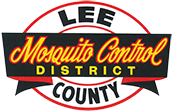St. Louis Encephalitis
Lee County Mosquito Control has a proactive, year round mosquito-borne disease surveillance program. It is the only program in Florida able to test for mosquito borne disease in a multi-pronged approach. The program is made up of four parts. The first part is sentinel chicken surveillance. This portion uses the appearance of mosquito-borne disease in chickens strategically placed around the county to monitor the transmission of disease among the disease’s reservoir host, birds. The second part of the program is specialized adult mosquito trapping. This trapping is performed with CDC light traps to monitor the level of the vector mosquito, Culex nigripalpus. The third part is the analysis of the collected vector mosquito using RT_PCR to detect the presence of viral RNA. This data indicates the presence of infected or potentially infected mosquitoes. The final part is human investigation. Human case investigation involves determining when and where a disease was contracted. The disease contraction could be outside the neighborhood of the victim or outside the country. When a mosquito borne disease is detected in a sentinel chicken, mosquito or human the District responds immediately to control adult mosquitoes in the vicinity of the disease detection to try and prevent the further spread of the disease by mosquitoes.
Saint Louis encephalitis virus (SLEV) is transmitted to humans by the bite of an infected mosquito. Most cases of SLEV disease have occurred in eastern and central states. Most persons infected with SLEV have no apparent illness. Initial symptoms of those who become ill include fever, headache, nausea, vomiting, and tiredness. Severe neuroinvasive disease (often involving encephalitis, an inflammation of the brain) occurs more commonly in older adults. In rare cases, long-term disability or death can result. There is no specific treatment for SLEV infection; care is based on symptoms. You can reduce your risk of being infected with SLEV by using insect repellent, wearing protective clothing, and staying indoors while mosquitoes are most active. If you think you or a family member may have SLEV neuroinvasive disease, it is important to consult your healthcare provider for proper diagnosis. (http://www.cdc.gov/sle/).
Tips for Protecting Yourself
- One preventable risk factor is going outdoors, for even short periods of time, unprotected. Persons making short outdoor trips to put out the trash, get the mail, or use tobacco should take the same protective precautions as persons who spend longer periods of time outdoors.
“DRAIN & COVER” TO PROTECT YOURSELF FROM MOSQUITO-BORNE DISEASES. - Drain water from garbage cans, house gutters, buckets, pool covers, coolers, toys, flower pots, or any other container where sprinkler or rain water has collected.
- Discard old tires, drums, bottles, cans, pots and pans, broken appliances, and other items that are not being used.
Empty and clean birdbaths and pets’ water bowls at one or two times a week.
Protect boats and vehicles from rain with tarps that do not accumulate water. Pump out bilges on boats.
Maintain swimming pools in good condition and keep appropriately chlorinated. Empty plastic swimming pools when not in use. - Cover skin with clothing or insect repellent.
- Wear shoes, socks, and long pants & long-sleeves. (This type of protection may be necessary for people who must work in areas where mosquitoes are present.)
Choose insect repellents with DEET(N,N-diethyl-m-toluamide), picaridin, oil of lemon eucalyptus, or IR3535.
Always read label directions carefully for the approved usage before applying a repellent.
In protecting children, read label instructions to be sure the repellent is appropriate: DEET is not recommended on children younger than 2 months old, and oil of lemon eucalyptus should not be used on children less than 3 years old.
Apply mosquito repellent to bare skin and clothing. Always read label directions carefully. Use mosquito netting to protect children younger than 2 months of age.
Do not allow young children to apply insect repellent to themselves; have an adult apply it. Adults should apply repellent first to their own hands and then transfer it to the child’s skin and clothing.
Apply insect repellent to exposed skin or onto clothing, but not under clothing. Do not apply repellent to the eyes or mouth, cuts, wounds, or irritated skin.
If additional protection is necessary, apply a permethrin repellent directly to clothing or gear. Always follow the manufacturer’s directions. - Cover doors and windows with screens to keep mosquitoes out of the house. Repair broken screens on windows, doors, porches, and patios.
For a fact sheet on SLEV click here.
For technical information on SLE go to: http://www.cdc.gov/sle/technical/fact.html
